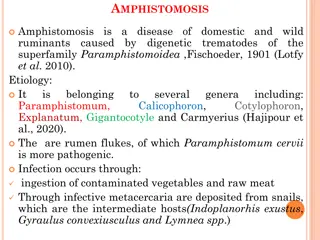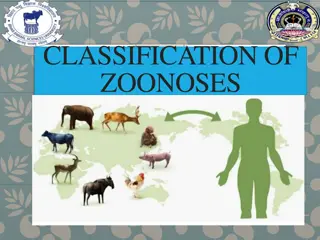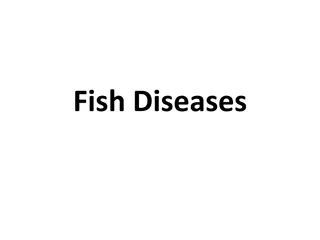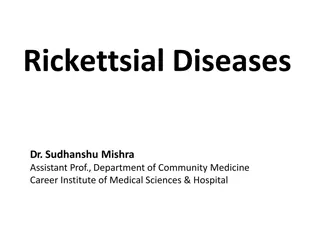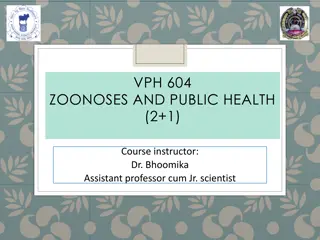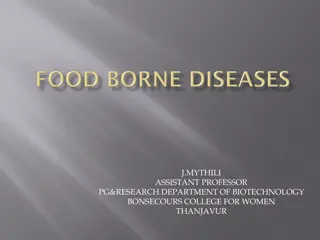Understanding Rickettsial Diseases: Causes, Symptoms, and Diagnosis
Rickettsial diseases are caused by various bacterial agents transmitted through insect vectors, affecting both humans and animals. This article covers the classification, etiology, pathogenesis, case definitions, and clinical scenarios related to rickettsial infections, helping readers understand the seriousness of the situation and how to identify and manage these diseases effectively.
Download Presentation

Please find below an Image/Link to download the presentation.
The content on the website is provided AS IS for your information and personal use only. It may not be sold, licensed, or shared on other websites without obtaining consent from the author. Download presentation by click this link. If you encounter any issues during the download, it is possible that the publisher has removed the file from their server.
E N D
Presentation Transcript
The Lousy Problem Dr. Dona Banerjee DCH, MD.
CLASSIFICATION OF RICKETTSIAL DISEASE DISEASES RICKETTSIAL AGENTS INSECT VECTORS MAMMALIAN VECTORS Typhus group a. Epidemic typhus b. Murine typhus c. Scrub typhus R.prowazekki R.typhi O.tsutsugamushi Louse Flea Mite Humans Rodents Rodents Spotted fever group a. Indian tick typhus b. Rocky mountain spotted fever c. Rickettsial pox R.conorii R.rickettsii Tick Tick Rodents, dogs Rodents, dogs R.akari Mite Mice Others a. b. Q fever Trench fever C.brunetti Rochjalimaea Quintana Nil Louse Cattle, sheep, goats Humans
Etiology Scrub typhus is caused by Orientia tsutsugamushi, a Gram-negative bacterium of family Rickettsiaceae. It is an intracellular pathogen, and many antigenic strains have been identified over the years from the original three strains (Karp, Kato, and Gilliam). Infection with one strain of the pathogen does not provide immunity to the other strains Vectors: Rodents, Mite
Pathogenesis Proliferation on the endothelium of small blood vessels Release of cytokines Damage to endothelial integrity Fluid leakage, platelet aggregation, polymorph, monocytic infiltration Focal occlusive end arteritis (Microvasculitis) Microinfarct
CASE DEFINITIONS Suspected case: A patient having compatible clinical scenario, suggestive epidemiological features and absence of definite alternative diagnosis should be termed as a suspected case of rickettsia. Definition of compatible clinical scenario and suggestive epidemiological features and list of differential diagnosis is provided in Box 1, 2 and 3, respectively. Alternative diagnosis can be searched from (but not limited to) the list of differential diagnoses
BOX 1 Compatible Clinical Scenario for Rickettsial Infection One or more of the following: Undifferentiated fever of more than 5 days. Sepsis of unclear etiology. Fever with rash. Fever with edema. Dengue-like disease. Fever with headache and myalgia. Fever with hepatosplenomegaly and / or lymphadenopathy. Aseptic meningitis / meningoencephalitis / acute encephalitic syndrome. Fever with cough and pulmonary infiltrates or community acquired pneumonia. Fever with acute kidney injury. Fever with acute gastrointestinal or hepatic involvement.
BOX 2 Suggestive Epidemiological Features for Rickettsial Infections One or more of the following within 14 days of illness onset: Tick bite. Ticks seen on clothes or in and around homes or in areas where children play Visit to areas which are common habitats of vectors like high uncut grass or weeds or bushes or rice fields or woodlands (where rodents share habitats with animals) or grassy lawns or river banks or poorly maintained kitchen gardens. Animal sheds in proximity of homes. Contact with pet or stray dog infested with ticks. Living in or travel to areas endemic for rickettsial diseases. Occurrence of similar clinical cases simultaneously or sequentially in family members, coworkers, neighbourhood or pets. Exposure to rodents.
BOX 3 Differential Diagnoses For Rickettsial Infections* Viral diseases: enteroviral diseases, measles, dengue fever, chikungunya, infectious mononucleosis. Bacterial diseases: meningococcemia, leptospirosis, typhoid fever, scarlet fever, secondary syphilis, infective endocarditis. Protozoal diseases: malaria. Vasculitis: Kawasaki disease, thrombotic thrombocytopenic purpura. Adverse drug reactions. Differential diagnoses pertaining to each systemic presentation. * Not an exhaustive list.
Probable case: Suspected case having either eschar, or having rapid (<48 hours) defervescence with anti-rickettsial therapy, or having suggestive laboratory features (Box 4), or having Weil-Felix test positive with titre of 1:80 or more in OX2, OX19 or OXK or positive IgM ELISA for rickettsia (optical density >0.5).
BOX 4 Suggestive Laboratory Features For Rickettsial Infections Normal to low total leukocyte count with a shift to left in early stages and leukocytosis later on Thrombocytopenia Raised ESR and CRP Hyponatremia Hypoalbuminemia and Elevated hepatic transaminases.
Confirmed case: Suspected case having rickettsial DNA detected in whole blood or tissue samples, or fourfold rise in antibody titres on acute and convalescent sera detected by immunofluorescence assay (IFA) or immuno-peroxidase assay (IPA) [8]. In countries like India, where PCR and IFA are not commonly available, properly performed paired serological tests like ELISA have high positive predictive value
Neurological presentation (meningoencephalistis n = 21, 34.4%). The most frequent manifestations included vomiting (n = 39, 63.9%), abdominal pain (n = 33, 54.1%), lymphadenopathy (n = 36, 59%), hepatosplenomegaly (n = 32, 52.5%), pedal edema (n = 32, 52.5%) and eschar formation (n = 30, 49.2%). 61 had confirmed scrub typhus.
Diagnosis Weil-felix test Scrub typhus IGM Immunofloroscence assay(IFA)
Weil Felix test The sharing of antigens between rickettsia and proteus is the basis of this heterophile antibody test. It demonstrates agglutinins to Proteus vulgaris strain OX 19, OX2 and OX K Poor in specificity and sensitivity (43% 59%) . It should be interpreted in conjunction with history and clinical findings. Can be used as a screening test in developing countries DISEASES Rocky Mountain Spotted Fever or Indian Tick typhus OX-19 OX-2 OX-K +++ + - Epidemic or Endemic typhus +++ + - - - ++++ Scrub typhus
Treatment Treatment must be initiated empirically in suspected cases without awaiting laboratory confirmation, as morbidity and mortality escalate rapidly with each day of treatment delay. Treatment should not be discontinued solely on the basis of a negative test result
Highlights. Acute febrile illness caused by Orientia tsutsugamushi and spread by the bite of the larval form of the trombiculid mite. It is one of the differential diagnoses to be considered in a child presenting with acute undifferentiated fever. A painless eschar, enlarged liver or spleen, and thrombocytopenia are pointers towards the possibility of scrub typhus
If scrub typhus is endemic to the locality, it is important to search for an eschar, especially in the folds of the axilla, neck, and groin. Weil Felix test has poor sensitivity. Scrub typhus IgM by ELISA is useful for confirmatory diagnosis, but is useful only after 5 7 days following onset of illness. Treatment: Doxycycline (4.5 mg/kg/day in two divided doses up to a maximum of 100 mg twice daily for 7 14 days). Alternatives are azithromycin or chloramphenicol.
Take home message Rickettsial diseases are present in India and in our state also.. Suspect Rickettsia early in cases of PUO. Any PUO of infectious etiology, more than 7 days, negative for Malaria, dengue ,Typhoid and especially if the patient is from rural or suburban areas, with features of multiorgan dysfunction ,it should be taken as a rickettsia unless proved otherwise.







